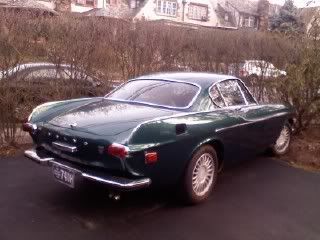In addition to what I posted to the same question in the GRM forum, it should be noted that 1800's have rather poor ventilation and can be hotter than hell in the Summer.
The Yahoo 1800list group is pretty much the best source for information about keeping one running. The Brickboard is ok... but I have yet to find any decent forum for them that bests the Yahoo group.
Like I hinted at in the other post, make damn sure your g/f drives the car before you go much further. I spend a fair amount of time driving one and it really does feel like a truck with a sporty looking body...
And now for some 1800 history:
P1800 - first 6K cars built in England by Jenson
1800S - Production moved to Sweden around 1964 due to generally poor build quality; some styling and drivetrain changes up to 1969; "P" dropped from model name; dual channel 4-wheel disc brakes repalced disc/drums in 1969.
1800E - ('70-'72) Styling similar; interior changes; Bosch D-Jetronic fuel injection added; automatic option added; compression lowered in '72 to meet emissions.
1800ES - ('72&'73) Sport-wagon body style; mechanically the same as the '72 E (lower compression engine).
Random thoughts:
No 1800 had power steering, although some have adapted the system from the the mechanically similar 164 series with mixed results.
Air conditioning was a dealer installed option and marginally effective. Better in the coupes than in the more greenhouse-like ES.
Did we mention rust yet? Check for it: frame sections, floors, behind/under the headlights, radiator support frame; sway-bar mount; rockers under the doors; fenders and quarters; windshield.
The earlier cars had a rather stupd gas filler on top of the rear fender which would get clogged with debris, fill with water, rust and dump water into the gas tank. Later E cars have the filler on the side.
I could go on... I do love these cars... and I don't mean to disuade you... just be sure you and your g/f know what you're getting into.

































